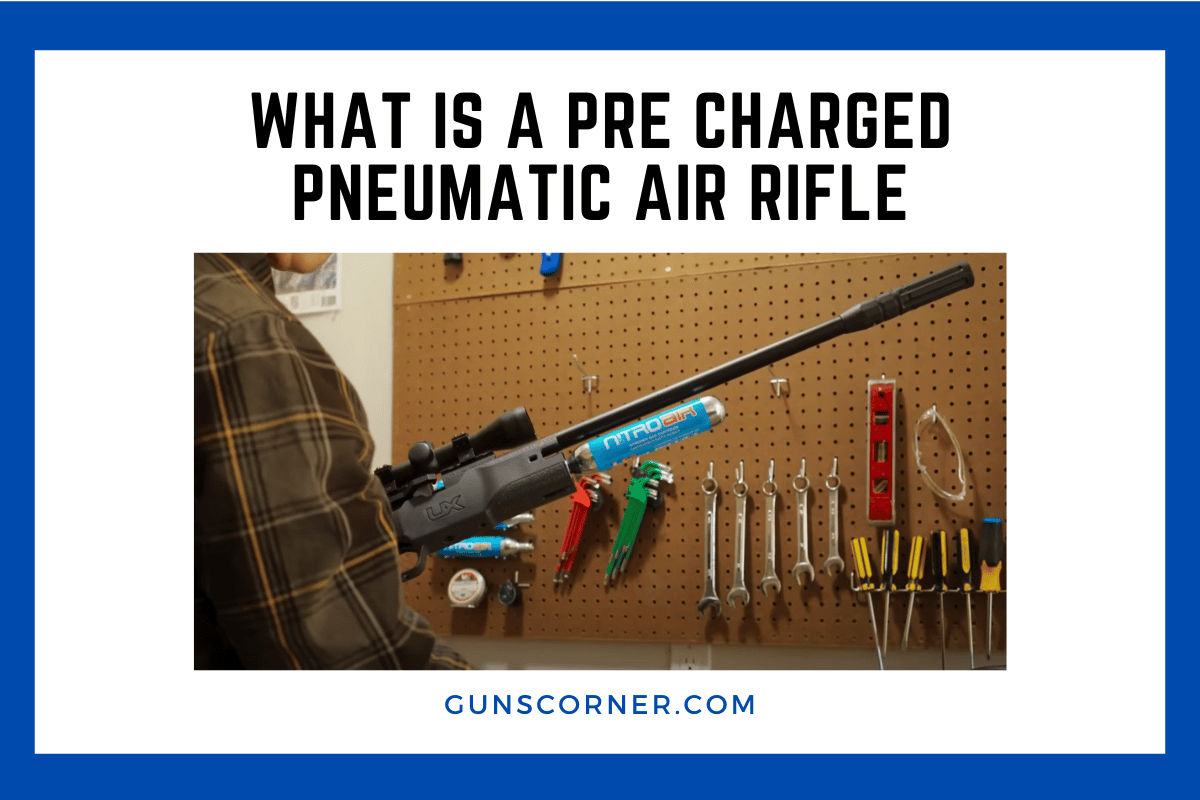Pre-charged pneumatic air rifles, often called PCP air rifles, use compressed air to shoot pellets. These guns have a tank filled with high-pressure air that powers multiple shots.
PCP air rifles offer more power, accuracy, and shot capacity than traditional spring-powered air guns.
PCP rifles work by releasing a small amount of compressed air each time the trigger is pulled. This pushes the pellet out of the barrel at high speed. The air is stored in a pressurized tank that can be refilled when empty.
These air rifles come in many styles for different uses. Some are made for target shooting, while others are designed for hunting small game. PCP rifles are known for their low recoil and quiet operation compared to firearms.
Key Takeaways
- PCP air rifles use compressed air to fire multiple shots without reloading
- They offer improved accuracy and power over traditional spring-powered air guns
- PCP rifles require periodic refilling of their air tanks to maintain performance
History and Development of PCP Air Rifles
The history of pre-charged pneumatic (PCP) air rifles goes back centuries. The first recorded drawing of a PCP airgun dates to the 16th century, created by French gunmaker Marin LeBourgeoys.
These early airguns used compressed air to propel projectiles. They were powerful and silent, making them popular for hunting and warfare.
PCP technology saw major advancements in the 18th and 19th centuries. Improved valves and air reservoirs increased power and shot capacity.
In the 20th century, PCP air rifles became more accessible to civilian shooters. Modern manufacturing techniques allowed for more affordable and reliable designs.
Today’s PCP air rifles offer high power, accuracy, and versatility. They can achieve air pressures up to 3,000-3,600 psi.
Popular PCP hunting rifles now come in large calibers like .25, .30, .35 and even .45. This allows them to take down medium-sized game animals.
The main drawback of PCP rifles is the need for external air filling equipment. Users must have a pump or scuba tank to refill the air reservoir.
Mechanics of Pre-Charged Pneumatic Air Rifles
Pre-charged pneumatic (PCP) air rifles use compressed air to propel pellets. They offer high power and accuracy without recoil. Let’s explore how they work and their key parts.
Operating Principle
PCP air rifles store compressed air in a tank. When fired, a valve releases some air. This air pushes the pellet down the barrel.
The trick is in a balance of energy. A spring-loaded hammer hits a valve, opening it briefly.
The sudden rush of air propels the pellet. After each shot, the valve closes to keep most air in the tank for later shots.
PCP rifles can fire many times before needing a refill. The number depends on the tank size and air pressure.
Key Components
PCP air rifles have several important parts:
- Air tank: Holds compressed air at high pressure
- Valve: Controls air release
- Hammer: Opens the valve when triggered
- Barrel: Guides the pellet
- Trigger: Starts the firing process
The air tank is pressurized before use. This can be done with a hand pump or scuba tank. A pressure gauge shows how much air is left.
The valve is crucial. It must open and close quickly to ensure each shot uses the right amount of air. A good valve design helps maintain consistent power.
Types and Uses of PCP Air Rifles
PCP air rifles come in various designs suited for different purposes. They range from compact models for plinking to high-powered versions for hunting large game. Some rifles excel in precision shooting for competitions.
Sporting and Hunting Models
PCP air rifles offer power and accuracy for hunting small to medium-sized game. Many models feature adjustable power settings to suit different hunting scenarios.
Sporting rifles often have lighter designs for easier carrying in the field. Some popular calibers for hunting include .22, .25, and .30.
Multi-shot magazines allow quick follow-up shots when hunting. This feature is especially useful for pest control or hunting fast-moving targets.
Hunting models may include sound moderators to reduce noise. This helps avoid spooking nearby animals during hunts.
Competition and Target Shooting
Competition PCP rifles are built for extreme accuracy. They often have match-grade barrels and adjustable stocks for a perfect fit.
These rifles typically use smaller calibers like .177 or .22 for target shooting. Smaller pellets are less affected by wind, improving long-range accuracy.
Target shooting PCP rifles often have specialized features like:
- Precision triggers with light pull weights
- Adjustable cheek pieces and butt pads
- Built-in pressure gauges for consistent shots
- High-capacity air tanks for extended shooting sessions
Many competition models allow fine-tuning of velocity and other settings. This helps shooters optimize their rifles for specific match conditions.
Maintenance and Safety Considerations
Proper care of a pre-charged pneumatic (PCP) air rifle is crucial for its longevity and safe operation.
Regular PCP air rifle maintenance includes cleaning the barrel and checking for any air leaks.
It’s important to keep the rifle’s pressure gauge in good condition. This helps prevent overfilling, which can be dangerous.
Safety is paramount when handling any air rifle.
Always treat the gun as if it’s loaded and never point it at anything you don’t intend to shoot.
When not in use, store the rifle in a secure location away from children and unauthorized users.
Use a gun safe or lockable cabinet if possible.
Before each use, inspect the rifle for any signs of damage or wear.
Pay special attention to seals and O-rings, as these can deteriorate over time.
Proper eye protection should always be worn when shooting. This guards against potential ricochets or debris.
Regular lubrication of moving parts is essential.
However, be cautious not to over-lubricate, as this can attract dirt and cause malfunctions.
When filling the air tank, follow the manufacturer’s guidelines carefully.
Overfilling can lead to dangerous pressure levels.
Lastly, it’s advisable to have the rifle serviced by a professional periodically.
They can perform more in-depth maintenance and ensure optimal performance.

